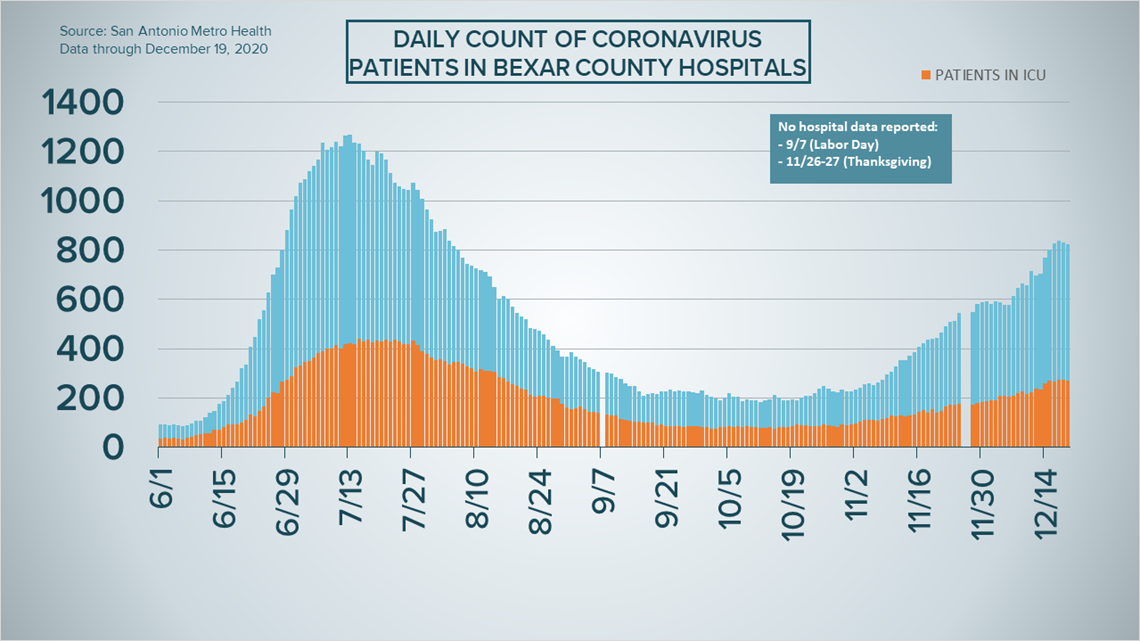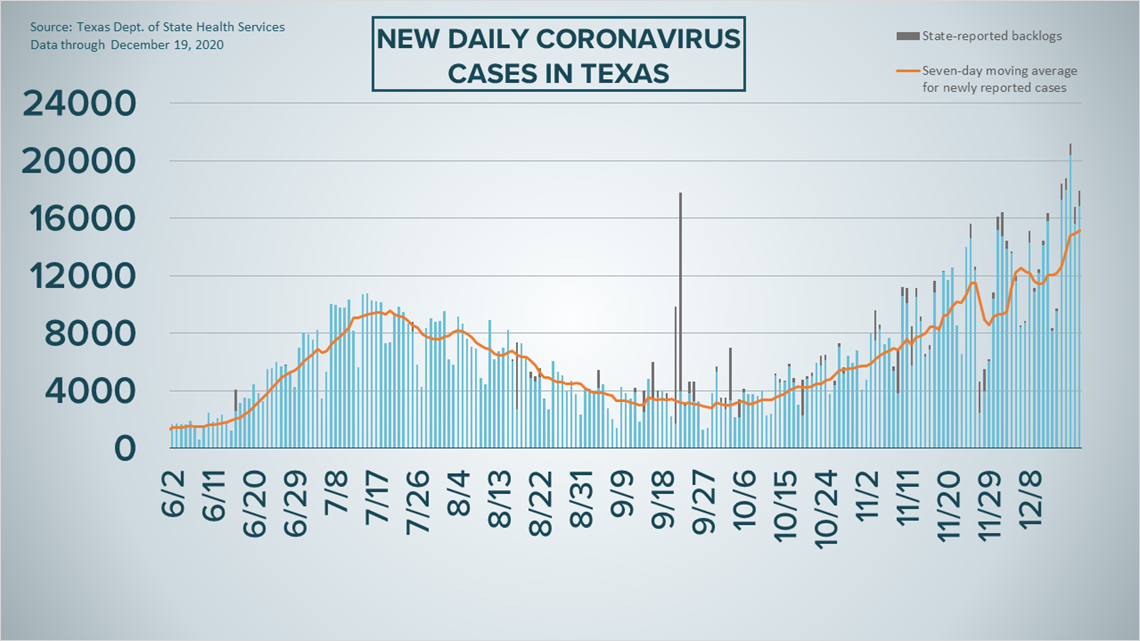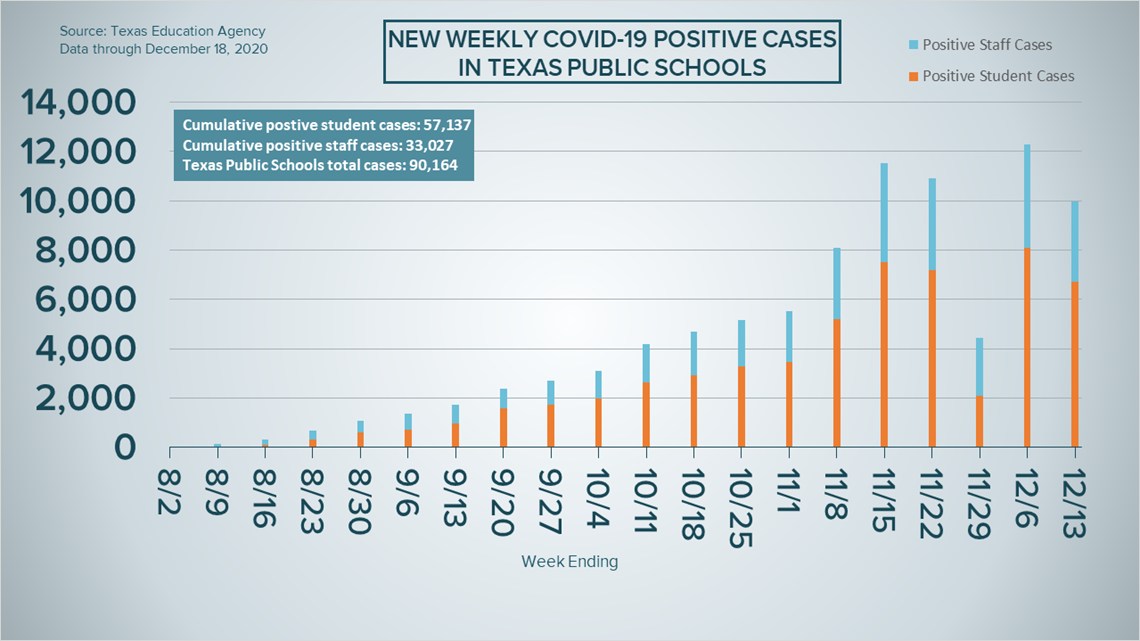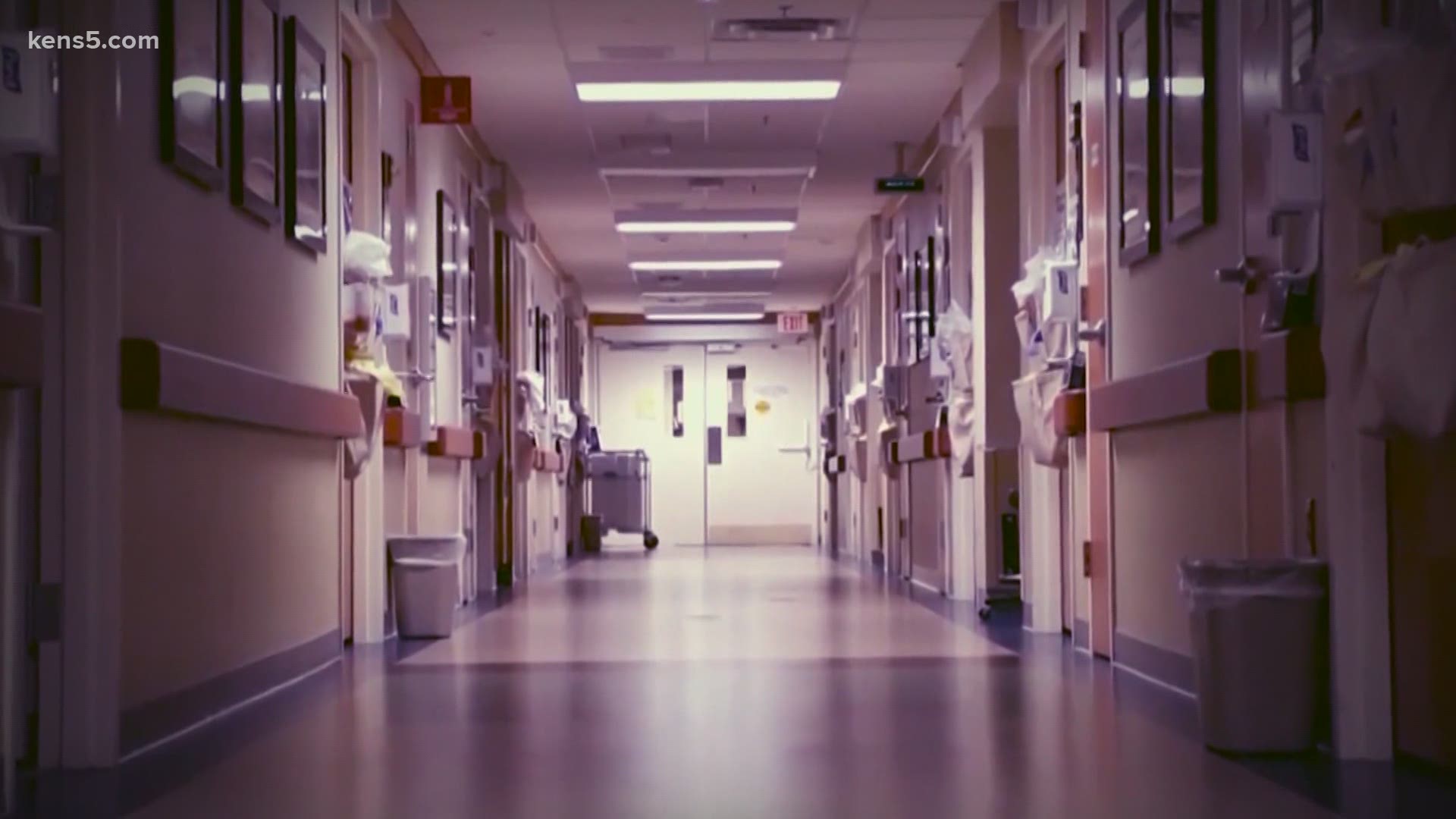SAN ANTONIO — We're tracking the latest numbers from the coronavirus pandemic in San Antonio and across Texas. Here are the latest numbers reported by Bexar and surrounding counties:
- Bexar County: 744 new cases were reported on Saturday, bringing the total number of cases to 100,822. No new deaths were reported, so the death toll from COVID-19 complications remains at 1,442.
- Hays County: Officials in Hays County on Friday reported 71 new cases in the county and three additional COVID-related fatalities. As of Friday, there are a total of 8,759 lab-confirmed local cases (1,262 of which are active), while the death toll jumped to 119. 7,378 residents have recovered from the virus.
- Comal County: Comal County reported an additional 108 coronavirus cases – 11 confirmed, 93 probable, and nine deemed "suspect" – on Friday, bringing its total to 5,684. No additional coronavirus-related fatalities were reported; the death toll for the county stands at 141. The county estimates 745 active cases on Friday, while 4,798 residents have recovered.
More county case information is available through the Texas Department of Health Services COVID-19 dashboard.
How Bexar County is trending
We've tracked how many coronavirus cases have been confirmed in Bexar County from the time officials began reporting cases in March 2020. The graphic below shows the number of cases since June and charts those daily case numbers along a 7-day moving average to provide a more accurate picture of the overall coronavirus case curve in our area and the direction we're trending amid the pandemic.
On Saturday evening, Metro Health updated its online coronavirus-tracking dashboards to reflect an additional 744 novel coronavirus cases in Bexar County—the lowest daily total since 599 diagnoses were reported on Monday. In all, 100,822 county residents have been diagnosed with COVID-19.
Health authorities also reported no new coronavirus-related deaths; 1,442 residents have died from coronavirus complications in all.


For the third straight day, the number of patients receiving treatment for their COVID-19 symptoms at local hospitals went down. On Saturday, the figure was 824; of those 133 are on ventilators and 268 are in intensive care. Both of those numbers are down slightly from Friday as well.


Coronavirus in Texas
The total number of novel coronavirus cases in the state since the pandemic began grew by 17,907 on Saturday, according to the Texas Department of State Health Services. That total includes 12,914 new confirmed cases, 3,974 new probable cases and 1,019 cases attributed to backlogs not previously reported in the state's total (more details can be found at the top of this page).
As of Saturday, nearly 1.574 million Texans have been diagnosed with COVID-19. The state's seven-day moving average for daily cases has risen to 15,136, marking the highest seven-day average recorded in the ongoing pandemic.


State health authorities also reported 272 additional virus-related deaths on Saturday. At least 25,226 Texans have died from COVID-19 complications. Meanwhile, 9,796 Texans were receiving treatment at hospitals for coronavirus symptoms on Saturday—the highest that figure has been since July 25.
Meanwhile, the state estimates that 1.261 million Texans have recovered, while 273,855 Texans remain ill with COVID-19.
The latest update from the Texas Education Agency showed that there have been at least 90,164 cumulative cases among staff and students across the state through Dec. 13. That number comprises 57,137 positive student cases and 33,027 staff cases. More information can be found here.


The TEA releases new data on school cases on Fridays.
Latest Coronavirus Headlines
- Fight over Federal Reserve powers stalls $900 billion COVID-19 aid plan
- US reaches nearly a quarter million daily COVID-19 cases
- 'Santa Claus is good to go' | Fauci tells Elmo, kids he vaccinated St. Nick
- COVID-19 VACCINE TRACKER: What you need to know about effectiveness and distribution phases in San Antonio and South Texas
- 'We have to have faith': As Bexar Co. reaches 'devastating' milestone in pandemic, second vaccine provides glimmer of hope
- Some Texas healthcare workers hesitant to take the vaccine while others can't wait for their turn
- COVID-19 vaccinations to increase as Bexar County surpasses 100,000 positive mark
- FDA gives green light to Moderna COVID-19 vaccine
- These facilities in Texas will receive some of its 620,000 vaccine doses in second week of distribution
Coronavirus symptoms
The symptoms of coronavirus can be similar to the flu or a bad cold. Symptoms include fever or chills, cough, shortness of breath or difficulty breathing, fatigue, muscle or body aches, headache, new loss of taste or smell sore throat, congestion or runny nose, nausea or vomiting and diarrhea, according to the Centers for Disease Control.
Most healthy people will have mild symptoms. A study of more than 72,000 patients by the Centers for Disease Control in China showed 80 percent of the cases there were mild.
But infections can cause pneumonia, severe acute respiratory syndrome, kidney failure, and even death, according to the World Health Organization. Older people with underlying health conditions are most at risk.
But infections can cause pneumonia, severe acute respiratory syndrome, kidney failure, and even death, according to the World Health Organization. Older people with underlying health conditions are most at risk.
Experts determined there was consistent evidence these conditions increase a person's risk, regardless of age:
- Chronic kidney disease
- COPD (chronic obstructive pulmonary disease)
- Obesity (BMI of 30 or higher)
- Immunocompromised state (weakened immune system) from solid organ transplant
- Serious heart conditions, such as heart failure, coronary artery disease, or cardiomyopathies
- Sickle cell disease
- Type 2 diabetes
The CDC believes symptoms may appear anywhere from two to 14 days after being exposed.
Human coronaviruses are usually spread...
- Between people who are in close contact with one another (within about 6 feet).
- Through respiratory droplets produced when an infected person coughs, sneezes or talks. These droplets can land in the mouths or noses of people who are nearby or possibly be inhaled into the lungs.
- Some recent studies have suggested that COVID-19 may be spread by people who are not showing symptoms.
Help stop the spread of coronavirus
- Stay home when you are sick.
- Eat and sleep separately from your family members
- Use different utensils and dishes
- Cover your cough or sneeze with your arm, not your hand.
- If you use a tissue, throw it in the trash.
Find a Testing Location
City officials recommend getting a COVID-19 test if you experience fever or chills, cough, shortness of breath or difficulty breathing, fatigue, muscle or body aches, headache, new loss of taste or smell, sore throat, congestion or runny nose, nausea or vomiting, or diarrhea.
San Antonio operates several no-cost testing locations, including two walk-up locations open Monday-Sunday from 10 a.m. until 2 p.m.:
Cuellar Community Center
5626 San Fernando St.
San Antonio, TX 78237
Ramirez Community Center
1011 Gillette Blvd.
San Antonio, TX 78224
Additionally, Freeman Coliseum offers drive-through no-cost testing from Monday through Sunday between 9 a.m. and 4 p.m. An appointment is required and can be made either online or by calling (833) 213-0643.
Here's a Testing Sites Locator to help you find the testing location closest to you in San Antonio. And here are the dates and times that city-run testing sites will be operating over the holidays.

